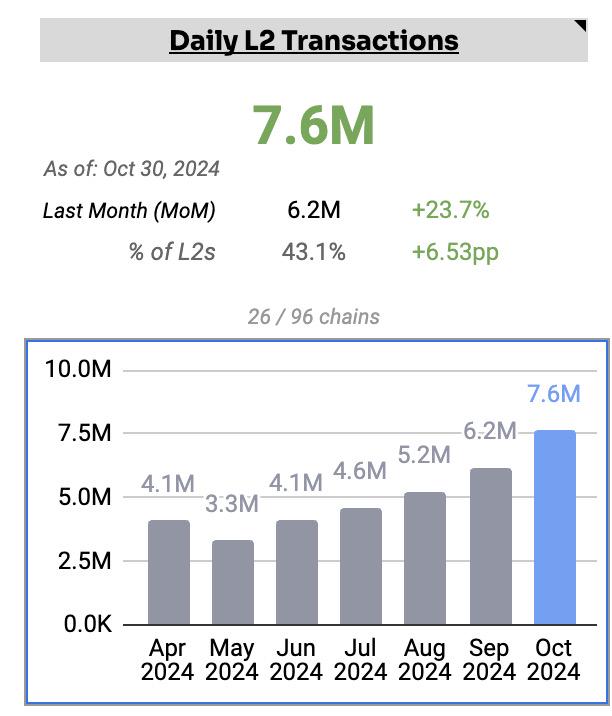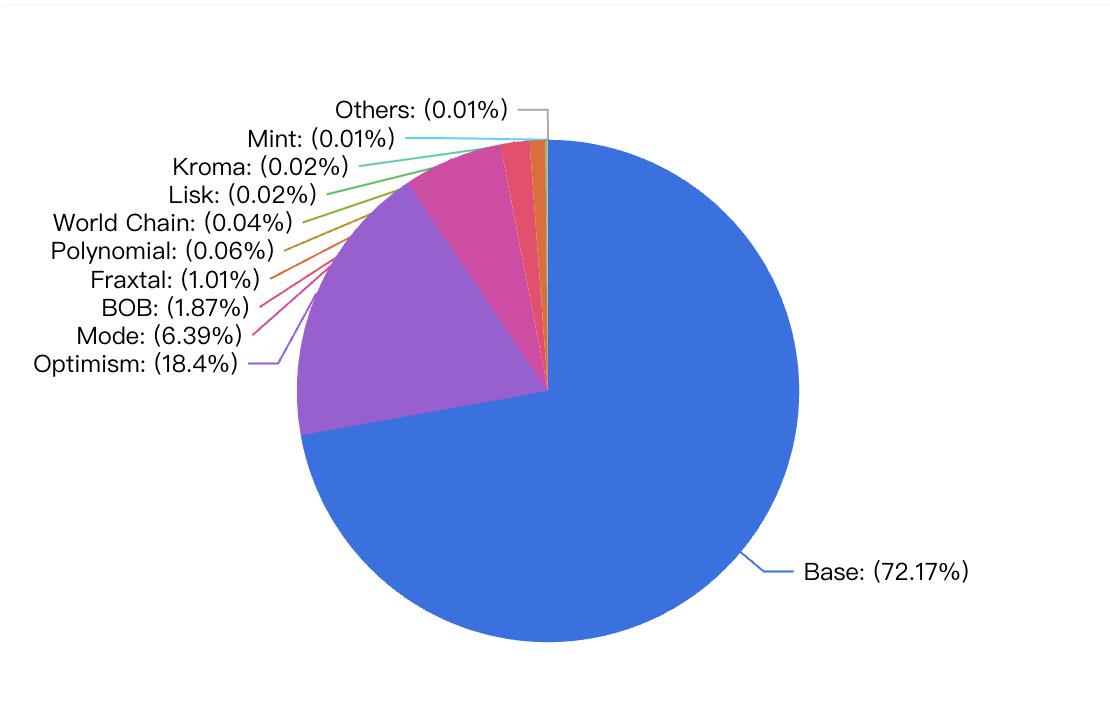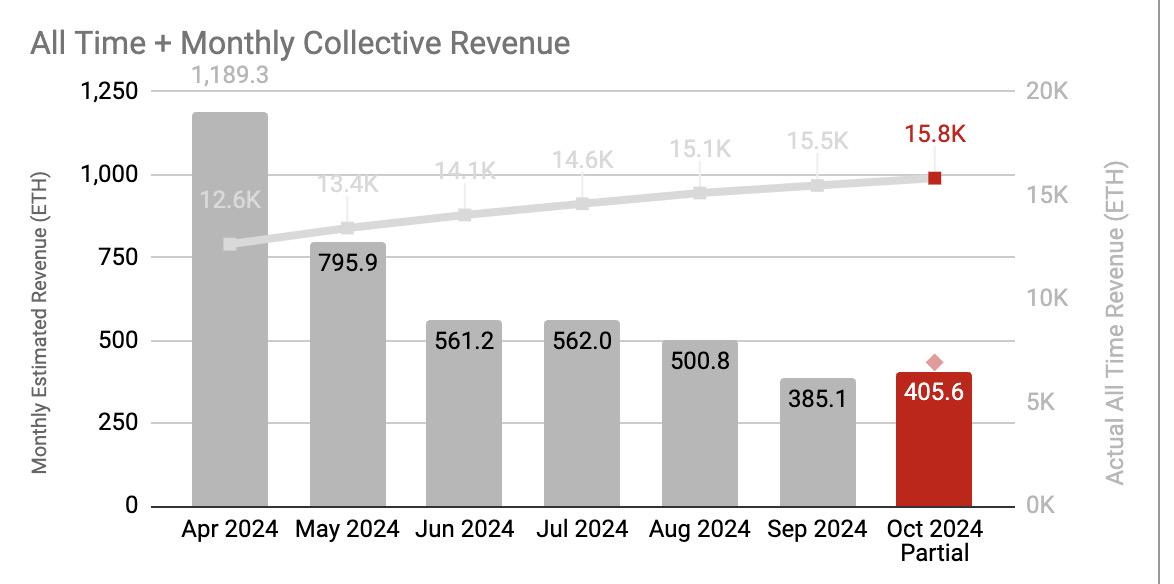Author: Nancy, PANews
In recent months, an increasing number of crypto projects have entered the L2 space, with the technical solution OP Stack frequently making appearances. The addition of several star projects has drawn significant market attention to OP Mainnet (Optimism). As the OP Stack ecosystem rapidly expands, the scale and activity of the Superchain ecosystem are also significantly increasing, largely due to the generous subsidy policies from OP Mainnet. However, at present, the revenue contributions from most Superchain projects remain relatively limited, primarily relying on the Base chain under Coinbase.
Nearly Half of Ethereum L2s Based on OP Stack, Superchain Daily Transactions Account for Over 40% of the Market
Coinbase launched the Ethereum L2 network Base based on OP Stack; Worldcoin announced the launch of the blockchain World Chain based on OP Stack and joined the Superchain; Uniswap introduced its own Layer2 network Unichain built on OP Stack technology; Sony's Layer2 blockchain Soneium uses the OP Stack codebase… In recent months, OP Stack has welcomed an increasing number of star participants.
In fact, OP Stack is currently one of the more popular and attractive L2 Stacks in the Ethereum L2 market. According to L2BEAT data, as of October 31, the number of Ethereum Layer2s has reached 111. Superchain Eco statistics show that 59 of these L2s are built on OP Stack, far exceeding other competitors, such as the 31 L2 projects using Arbitrum One and only 8 using Polygon.
Moreover, L2 projects running on OP Stack have significant influence. L2BEAT statistics indicate that among the top ten Ethereum L2s by TVL, six L2 projects use OP Stack as their technical solution, particularly Base, which ranks second with $8.17 billion.

As OP Stack continues to gain momentum, the Superchain ecosystem is also growing, serving as an important tool for OP Mainnet to address the fragmentation of the L2 ecosystem. According to Superchain Eco statistics, as of October 31, there are 36 OP Chains that have joined the Superchain ecosystem, with daily transaction counts reaching 7.6 million (a 23.7% increase from last month), accounting for 43.1% of the L2 market.

Additionally, DeFiLlama data shows that the TVL of OP Chains on Superchain has exceeded $3.67 billion. Among them, Base ranks first with a scale of $2.65 billion, accounting for 72.1%; followed by OP Mainnet with a TVL of $670 million, making up 18.4%; Mode follows closely with a TVL of over $230 million, accounting for nearly 6.4%. In contrast, most other projects have a TVL of less than $100 million, with some projects only having a few thousand dollars.
Generous Subsidies for Superchain, Over $42 Million in Revenue Mainly from Base Contributions
The rapid development of the OP Mainnet ecosystem is largely attributed to its generous funding subsidy strategy. This "scatter money" subsidy has not only successfully attracted numerous developers and projects but has also effectively incentivized market participants, laying a solid foundation for the rapid growth and prosperity of its ecosystem.
According to official documents, the Optimism Collective primarily supports builders through two types of funding: Retro Funding and Mission Grants. Official data shows that since 2022, the Optimism Collective has distributed over 60.81 million OP tokens in multiple rounds of Retro Funding, and has reserved 800 million OP tokens for future rounds of rewards. The funding scale for each project varies, ranging from a few thousand tokens to several hundred thousand tokens.
This strategy has also been applied to the construction of the Superchain ecosystem, making it more attractive among various L2 Stack solutions. For instance, in the fourth round of Retro Funding in April this year, 10 million OP tokens were specifically allocated for on-chain builders deploying contracts and generating block space demand on Superchain. In August, Optimism announced that it had awarded 50 million OP tokens to creators and builders of Superchain.
Currently, many Superchain members have received funding. For example, the Optimism Foundation has provided 118 million OP tokens to Base over the next six years; the DeFi L2 Mode based on OP Stack will receive 2 million OP tokens from the Optimism Foundation (valued at approximately $5.3 million at the time); the L2 network Ink launched by the U.S. crypto exchange Kraken received 25 million OP tokens in a deal reached earlier this year, currently valued at about $42.5 million, with tokens unlocking monthly; the Bitcoin L2 project BOB, as the first Bitcoin-native project integrated into the Superchain ecosystem, received OP tokens worth $870,000 from the Optimism Foundation; Mint Blockchain received a strategic investment of 750,000 OP tokens (valued at $1.35 million) from the Optimism Foundation…
Regarding the unlocking rules for these funded tokens, Mint Blockchain co-founder Shier Han revealed to PANews, "For projects with smaller token rewards, OP officials often provide direct subsidy support, but they also attach some incentive requirements for promoting ecosystem development. When blockchain projects conduct community rewards, they also set corresponding rules, such as ordinary users can directly earn rewards by using ecosystem applications, while application developer teams need to lock up tokens accordingly, with a normal lock-up period of one year. According to personnel from the Optimism Foundation, of the 25 million OP tokens allocated to Ink, 5 million are directly used for project development, while the remaining 20 million are released based on the scale of on-chain transaction counts. Therefore, for projects like Ink that receive substantial support, OP officials will sign more complex cooperation models such as betting agreements and assess contributions to key data like Gas fees."
Since each OP Chain operates under a standardized revenue-sharing model, these Superchains are required to contribute 2.5% of their total on-chain sequencer revenue or 15% of their net profit (whichever is higher) to the Optimism Collective. However, the economic benefits currently appear limited.

Superchain Eco statistics show that these Superchains have cumulatively contributed approximately 15,800 ETH in revenue (currently valued at over $42 million), with OP Mainnet contributing the most at over 12,800 ETH (accounting for 80.2%); followed by Base, which brought in about 2,878.7 ETH (accounting for 18.6%); other chains contributed less than 0.5% each. Moreover, Optimism Collective's monthly revenue has shown a downward trend, having decreased nearly 65.9% from April of this year. However, with the addition of more traffic-driven projects like Unichain and Ink, the revenue potential for OP Mainnet is expected to increase further.
免责声明:本文章仅代表作者个人观点,不代表本平台的立场和观点。本文章仅供信息分享,不构成对任何人的任何投资建议。用户与作者之间的任何争议,与本平台无关。如网页中刊载的文章或图片涉及侵权,请提供相关的权利证明和身份证明发送邮件到support@aicoin.com,本平台相关工作人员将会进行核查。




